| |
|
Featured in this Edition
Highlight: A+ Schools Program
 The SERVE Center welcomes the A+ Schools Program to its peerless team of education professionals. More information below. The SERVE Center welcomes the A+ Schools Program to its peerless team of education professionals. More information below.
Kindergarten transitions: Learn better ways to manage the process by which young children transition into kindergarten. More information on click here.
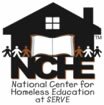 Out of house and home: The nation’s foreclosure crisis has very real effects on the numbers of students in our schools who experience homelessness. More information on click here Out of house and home: The nation’s foreclosure crisis has very real effects on the numbers of students in our schools who experience homelessness. More information on click here
Smaller learning communities: learn more about how this innovative collaboration model has revolutionized thinking about learning. More information on click here
|
Ludwig “Ludy” van Broekhuizen, Ph.D.
SERVE Center Executive Director 
Young children entering kindergarten, Spanish-speaking students in their first U.S. classroom, new freshmen with fears of high school, first year teachers preparing for their first week of school, high school graduates taking first steps toward postsecondary opportunities…ahh, transitions. As the new school year begins, we might recall our own transitions. They may have been painful or graceful, successful or stressful, terrifying or exhilarating. No matter our experiences with transitions, they are an inevitable part of life. Yet the places and spaces to which we transition are not always equipped to receive us in positive, affirming, and supportive ways that nurture our success.
So what do we know about student transitions? This month’s PowerNotes brings to you helpful and important information related to transitions for homeless students, critical elements around transition, and transitioning to smaller learning communities. It also highlights SERVE Center’s newest program, A+Schools, a whole-school reform model that views the arts as fundamental to how teachers teach and students learn in all subjects. We hope this edition of PowerNotes empowers you to explore how to improve transitions in the context of your environment.
|
|
The A+ Schools Program Joins the SERVE Center
Gerry Howell
Program Director
On July 1, 2009, the A+ Schools Program received a warm welcome as the newest program at the SERVE Center. A+ Schools is a whole school “re-form” model that views the arts as fundamental to teaching and learning in all subjects. The Program mission is to create schools that work for everyone: students, teachers, administrators, parents, and the community.
Grounded in the A+ Essentials™, which outlines the commitment and practice of the Progra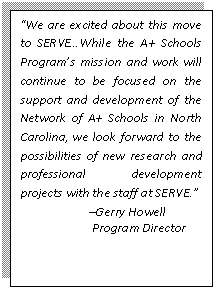 m and the participating schools, the central vision of A+ is to create enhanced learning opportunities for all students. This is accomplished by using arts-integrated instruction which incorporates Howard Gardner’s theory of multiple intelligences, other intelligence theories, recent brain research findings, and dance, drama, music, visual art, and creative writing. For schools, A+ is a comprehensive education reform because other school practices (assessment, scheduling, collaboration, parent involvement, and more) are reformed as necessary to achieve this central vision. m and the participating schools, the central vision of A+ is to create enhanced learning opportunities for all students. This is accomplished by using arts-integrated instruction which incorporates Howard Gardner’s theory of multiple intelligences, other intelligence theories, recent brain research findings, and dance, drama, music, visual art, and creative writing. For schools, A+ is a comprehensive education reform because other school practices (assessment, scheduling, collaboration, parent involvement, and more) are reformed as necessary to achieve this central vision.
Established in North Carolina in 1995 by the Kenan Institute for the Arts, the A+ Schools Program began with 25 schools representing the diversity of North Carolina schools and communities. In 2003, the A+ Schools Program moved from the Kenan Institute for the Arts to the University of North Carolina at Greensboro (UNCG). Currently, the North Carolina A+ Schools Network includes 43 schools with plans to add new schools each year.
Nationally and across North Carolina, the A+ Schools Program at the SERVE Center continues to provide consultation services and professional development to assist in establishing statewide and regional A+ Schools networks and partnerships. The Program is currently funded in part by the North Carolina State Legislature and by grants and contracts from public and private agencies and foundations.
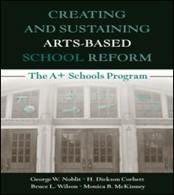 An intensive 4-year evaluation of the Program by independent researchers and a follow-up study after 8 years showed significant positive effects on schools, communities, teachers, and students. The results of the initial evaluation and the subsequent 8th-year evaluation are the topic of a recent book, Creating and Sustaining Arts-Based School Reform: The A+ Schools Program (2009, Noblit, Corbett, Wilson, & McKinney). The authors attributed the success and sustainability of the Program to: the use of the arts in school reform, professional development, and the statewide Network created to support teachers and schools. According to the researchers, A+ has been sustained because it became deeply engrained in teacher culture in the schools, and teachers reported that “the arts invite students to learn, and this makes teaching worthwhile.” An intensive 4-year evaluation of the Program by independent researchers and a follow-up study after 8 years showed significant positive effects on schools, communities, teachers, and students. The results of the initial evaluation and the subsequent 8th-year evaluation are the topic of a recent book, Creating and Sustaining Arts-Based School Reform: The A+ Schools Program (2009, Noblit, Corbett, Wilson, & McKinney). The authors attributed the success and sustainability of the Program to: the use of the arts in school reform, professional development, and the statewide Network created to support teachers and schools. According to the researchers, A+ has been sustained because it became deeply engrained in teacher culture in the schools, and teachers reported that “the arts invite students to learn, and this makes teaching worthwhile.”
The A+ Schools Program is now nationally recognized as an effective, research-based strategy for sustainable, arts-based school reform. It has been highlighted in national publications including Critical Links: Learning in the Arts and Student Academic and Social Development (2002, Arts Education Partnership), Putting the Arts in the Picture: Reframing Education in the 21st Century (2004, Center for Arts Policy at Columbia College Chicago), Third Space: When Learning Matters (2005, Arts Education Partnership), and more recently in Arts Integration Frameworks, Research & Practice: A Literature Review (2007, Arts Education Partnership).
In North Carolina, the A+ Schools Program has been recognized and cited extensively as an exemplary program by the North Carolina Department of Public Instruction as documented in two of its most recent publications, A Balanced Curriculum(elementary and middle schools editions).
 Gerry (left) has been the Director of the A+ Schools Program since 2004, and has extensive experience in the arts and education both in the public and private sectors. She was instrumental in co-creating the A+ Schools Program at the Kenan Institute for the Arts, and served as the Program and Professional Development Director from 1994 until 2004. Gerry (left) has been the Director of the A+ Schools Program since 2004, and has extensive experience in the arts and education both in the public and private sectors. She was instrumental in co-creating the A+ Schools Program at the Kenan Institute for the Arts, and served as the Program and Professional Development Director from 1994 until 2004.
Joining Gerry at the SERVE Center is Becky Crews, the A+ Program Coordinator. Becky provides support for tasks associated with conducting external professional development/training contracts and grants. She also participates in the ongoing planning, development, and conducting of A+ Network activities, and the development and dissemination of A+ materials
|
|
 A+ Essentials: A Set of CommitmentsTM A+ Essentials: A Set of CommitmentsTM
Arts
In A+ Schools the arts are:
- inclusive of drama, dance, music, visual arts and creative writing
- included in curriculum design
- integrated within ‘academic’ content areas
- taught daily
- valued as essential to learning and personal experiences part of the whole school’s identity
|
|
Curriculum
In A+ Schools curriculum is addressed through the use of:
- curriculum mapping by all teachers and specialists
- thematic webbing reflecting both horizontal and vertical alignment
- essential questions
- teacher created interdisciplinary thematic units
- cross-curricular and two-way integration
|
|
|
Multiple Intelligences
In A+ Schools MI theory:
- is used daily within planning and assessment
- is understood by administration, teachers, students and parents
- is studied and implemented… with a continued emphasis to explore new research creates balanced learning opportunities for students
|
|
|
Enriched Assessment
In A+ Schools Enriched Assessment is:
- designed for learning
- inclusive of arts and MI
- ongoing and integrated
- experiential and collaborative
- a reflective practice
- used to help meet school system requirements
- used as a self–assessment tool by teachers and students
|
|
|
Experiential Learning
In A+ Schools Experiential Learning:
- is grounded in arts-based instruction
- is a creative process
- acknowledges a range and variety of entry points
- includes differentiated instruction provides multifaceted assessment opportunities
|
|
Collaboration
In A+ Schools collaboration:
- is intentional and valued
- is given priority by providing time for classroom and special area teachers to plan together
- occurs throughout the day
- includes teachers, students, families, and local community
- includes broad-based leadership
|
|
Climate
In A+ Schools climate improves because:
- teachers grow professionally
- morale improves
- stress is reduced
- teachers better manage the arts in their classrooms
- teaching and learning through arts and MI is fun A+ whole-school reform is exciting
|
|
Infrastructure
In A+ Schools infrastructure supports the philosophy by:
- addressing logistics of daily school routines
- providing appropriate space for the arts
- continually developing faculty commitment
- creating a shared vision
- providing relevant professional development supporting team building
|
|
Created by the North Carolina A+ Schools Network, a network of teachers, coordinators, principals, and A+ Fellows.
Copyrighted by the A+ Schools Program at the University of North Carolina at Greensboro. Use by permission only.
|
|
SERVE Center PowerNotes
|
|
Planning for Terrific Transitions into Kindergarten
Lynn Amwake
Program Specialist
Successful transitions are built upon policies and procedures that are in place well before a child’s first day of kindergarten. Administrators are perhaps those most responsible for ensuring a smooth transition for children and families. Their leadership sets policies and procedures, oversees the budget, and outlines the agency priorities. Administrators can also begin the necessary cross-agency communications that are necessary for really effective transition plans.
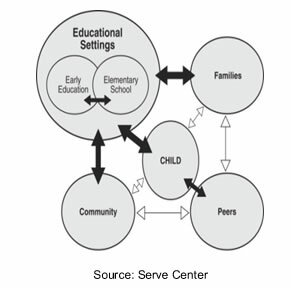
Effective transition practices are built upon strong connections between various partners. The diagram at left indicates the connections that must be in place in order to ensure an effective transition plan. The dark arrows indicate the key connections that are most important-early education setting to elementary school, families to educational setting (schools), child to school, community to school, and child to peers.
In order to assist schools with the transition process, the SERVE Center developed Planning for Terrific Transitions-A Guide for Transition-to-School Teams. This trainer’s guide is designed to facilitate an 8-hour transition to kindergarten training. The 5-step process takes into account the unique challenges of collaborating with a diverse set of team members, including early childhood staff, elementary staff, community partners, and parents. Copies of this training guide may be requested by emailing Lynn Amwake or calling (800).755-3277, extension number 8739. You can also visit the SERVE Center’s Transition website
|
|
SERVE Center PowerNotes
|
|
Housing Transitions and Foreclosure Crisis Spark Increased Interest in the McKinney-Vento Act
Christina Dukes
Program Specialist
Recently, our country has seen an unprecedented crisis develop within the housing market, resulting in higher foreclosure rates and higher numbers of students being identified as homeless in our schools. The McKinney-Vento Act,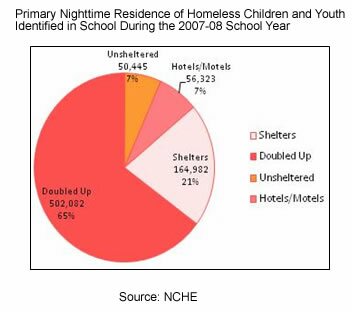 also known as Title X, Part C, of the No Child Left Behind Act, guarantees equal access to public education and provides supplemental supports to these students. also known as Title X, Part C, of the No Child Left Behind Act, guarantees equal access to public education and provides supplemental supports to these students.
Under the McKinney-Vento Act, every school district must appoint a local homeless education liaison to ensure that homeless students are identified and provided with needed services. Every state must also appoint a state coordinator for homeless education to oversee the implementation of the Act throughout the state.
The National Center for Homeless Education (NCHE) at The SERVE Center at UNCG is the information and technical assistance center for the federal Education for Homeless Children and Youths (EHCY) Program. If you’re interested in learning more about homeless education, visit the NCHE website.
|
|
|
|
Transitioning to Smaller Learning Communities
Adam Hall
Program Specialist
Smaller Learning Communities (SLCs) represent a sea change in secondary public education. As economic and high school dropout data become inextricably linked, American educators are faced with the undeniable truth—the traditional comprehensive high school must change. SLCs, as defined by both the United States Department of Education and the research, typically involve groups of students (150-400) working with a group of teachers over multiple years with a renewed focus on preparing academically for postsecondary life. A number of 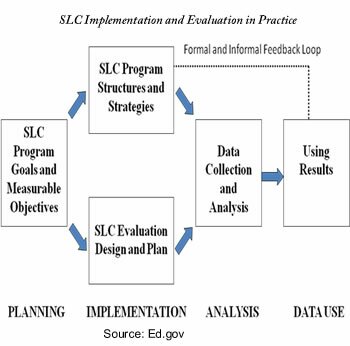 complementary structures and strategies are implemented based on student needs and school culture to aid the transition from a one-size-fits-all comprehensive paradigm to smaller and more personalized learning environments. Along the way, professional and personal relationships and beliefs are challenged, as widespread cultural shifts occur. The SERVE Center has worked with over 100 high schools as they transition to SLCs, gaining a unique perspective on the nature and challenges of change. We offer technical assistance based on experience and the research base balanced with our extensive work with real schools undergoing real transformations. Planning for and implementing SLCs is a defining moment for districts and schools. Stakeholder engagement, refinements to decision-making processes, and school and district leadership are often tested as the deeply held beliefs of the school community are discerned and addressed. At the same time, high schools transitioning to SLCs stand poised to serve their students in ways never before imagined, less defined by the constraints of managing 1,000 or more students and freer to customize instruction and support. complementary structures and strategies are implemented based on student needs and school culture to aid the transition from a one-size-fits-all comprehensive paradigm to smaller and more personalized learning environments. Along the way, professional and personal relationships and beliefs are challenged, as widespread cultural shifts occur. The SERVE Center has worked with over 100 high schools as they transition to SLCs, gaining a unique perspective on the nature and challenges of change. We offer technical assistance based on experience and the research base balanced with our extensive work with real schools undergoing real transformations. Planning for and implementing SLCs is a defining moment for districts and schools. Stakeholder engagement, refinements to decision-making processes, and school and district leadership are often tested as the deeply held beliefs of the school community are discerned and addressed. At the same time, high schools transitioning to SLCs stand poised to serve their students in ways never before imagined, less defined by the constraints of managing 1,000 or more students and freer to customize instruction and support.
The figure above lays out some of the processes that underlie effective SLCs. Other resources on the topic may be found on the Department of Education’s Smaller Learning Communities Program website.
|
|
SERVE Center PowerNotes
|
|

|
|








